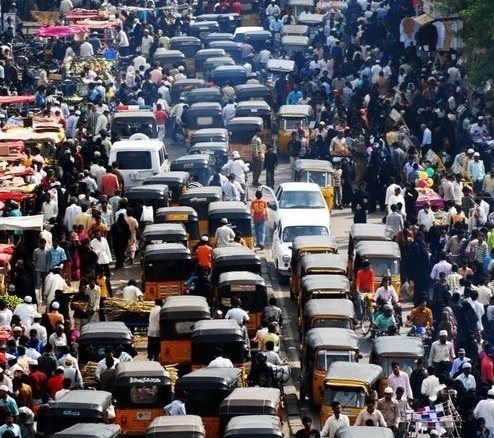There are four basic factors that cause population change in a country – Natality or the birth rate, Mortality or the death rate, immigration, and emigration. Besides these, there are other factors such as pull factors, push factors and refugees.
Natality and Mortality
The number of individuals borne in a unit period of time is called as Natality or the birth rate.
Further, the number of individuals dying in a given period is called as mortality or the death rate.
These rates are calculated taking 100 or 1000 as constant. For example, Natality and Mortality are expressed on ‘per one hundred’ or ‘per one thousand people’.
Diseases of mothers and infants, malnutrition of mothers and poverty result in coming down of the birth rate or the Natality.
Better mother and child care facilities and medical aids have enhanced Natality, the world over.
Mortality is regulated by public hygiene, availability of balanced food, economic conditions and availability of medical facilities.
The ratio of births and deaths is called as Vital Index.
Immigration and Emigration
Moving in of individuals is called as immigration and moving out of individuals is called as emigration.
When the population of one place is shifted to some other place, we call it as migration. In more concrete terms- movement of people, especially of whole groups, from one place, region, or country to another, particularly with the intention of making permanent settlement in a new location.
Immigration and emigration activities of people disturb the population load in a particular region, state or country.
It also causes the diffusion of cultures and changes in the forms of social organisations.
Migration of people caused hastening of the downfall of the Roman Empire in the 3rd to the 6th century A.D., which was followed by the construction of the Great China Wall for the prevention of eastward expansion of Central Asian Tribes.
Migration is one of the most important factors of population change.
While births and deaths are relatively easy to predict due to reliable age specific behaviour, migration is volatile, often changing due to housing market preferences, economic opportunities and changing household circumstances.
Other Factors
Some characteristics of a place attract people to accumulate and reside at a particular place. These characteristics are known as pull factors.
On the other hand, there are such factors that cause people to leave a particular place. Such factors are called as Push Factors.
Wars, life threatening discriminations, famines and natural disasters cause people to leave their countries and to settle in other countries. There, they are called as refugees.
Thus, these push factors affect the populations on both the sides. At one side, these factors cause population to shift elsewhere, but on the other side these factors cause addition of population burden.
There are a number of causes that lead to the growth of population at certain place. These causes are being given below –
1. Health; the control of disease, birth control measures, infant mortality, diet, and malnutrition, the number of doctors and nurses, sexual health education.
2. Education; health education, the age at which compulsory schooling finishes, females in education, levels of tertiary education, literacy levels.
3. Social provision; levels of care for the elderly, availability of radio and other forms of media, clean water supply.
4. Cultural factors religious attitudes to birth control, status gain from having children, the roles of women in society, sexual morality
5. Political factors; taxation to support services, strengths of the economy, impact of war and conflicts, access to health care and contraception
6. Environmental factors; frequency of hazards, environmental conditions that breed disease.
Age structure and its significance
A population is composed of individuals of different age groups. The proportion of individuals in each age group is called as age structure of the population.
The age structure is an important population characteristic which influences both the Natality and the mortality.
Mortality varies with age because chances of death are more towards early and late portions of life. In the same way, Natality or the reproduction is also restricted to certain age groups.
There are three main age structures in a population- Pre- reproductive, Reproductive and Post reproductive. The age structure of a population is related to its growth rate.
It is important to study age structure of a population in order to study different aspects of a population like- the work efficiency of people, their social status, their education levels, their pattern of occupation etc.
A larger size of population in the age group of 15-59 years indicates the chances of having a larger working population.
As percentage of working population is high, it can be predicted or assessed that the country can progress fast.
On the other hand, if the number of children in the population is high, the dependency ratio will be high.
Similarly, a growing population in the age group of more than 60 indicates towards greater expenditure on the care of the old and aged people.
The type of age structure has a direct influence on the future of a nation, since extremes, old age dependency as well as young age dependency prove to be a severe burden on the economy of a country.




